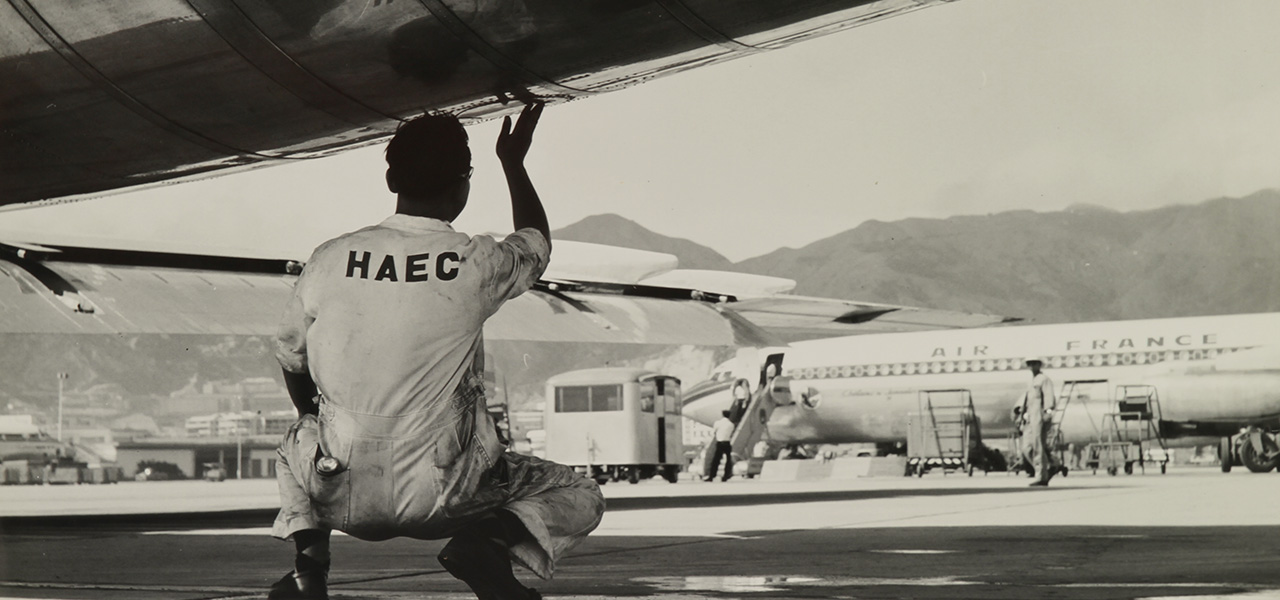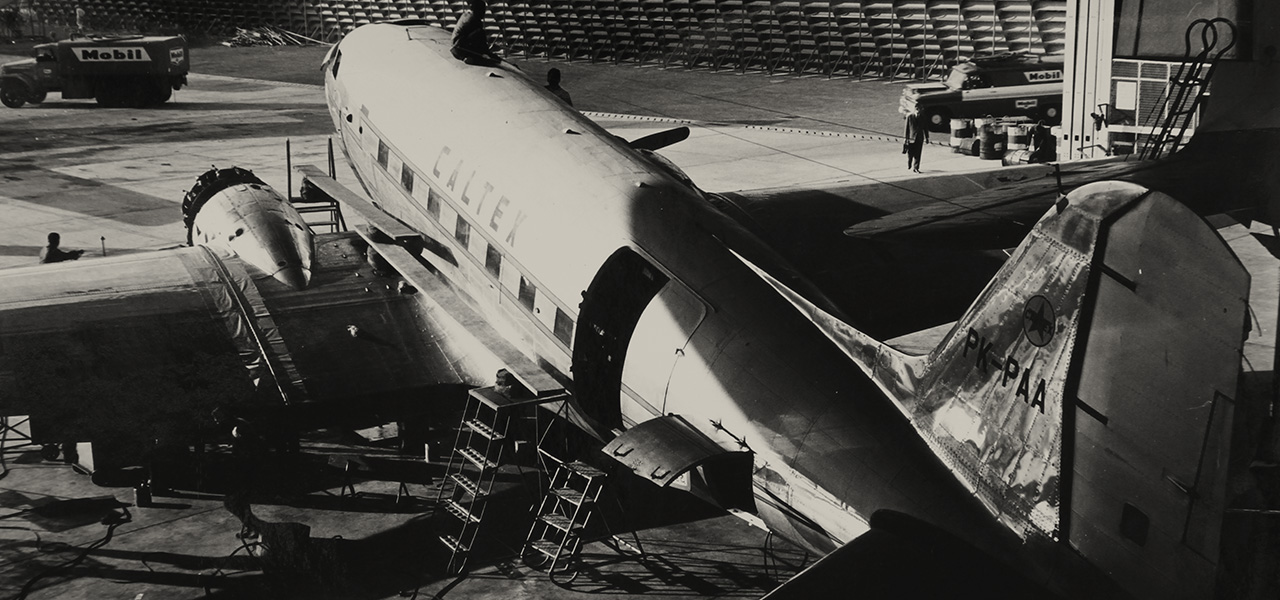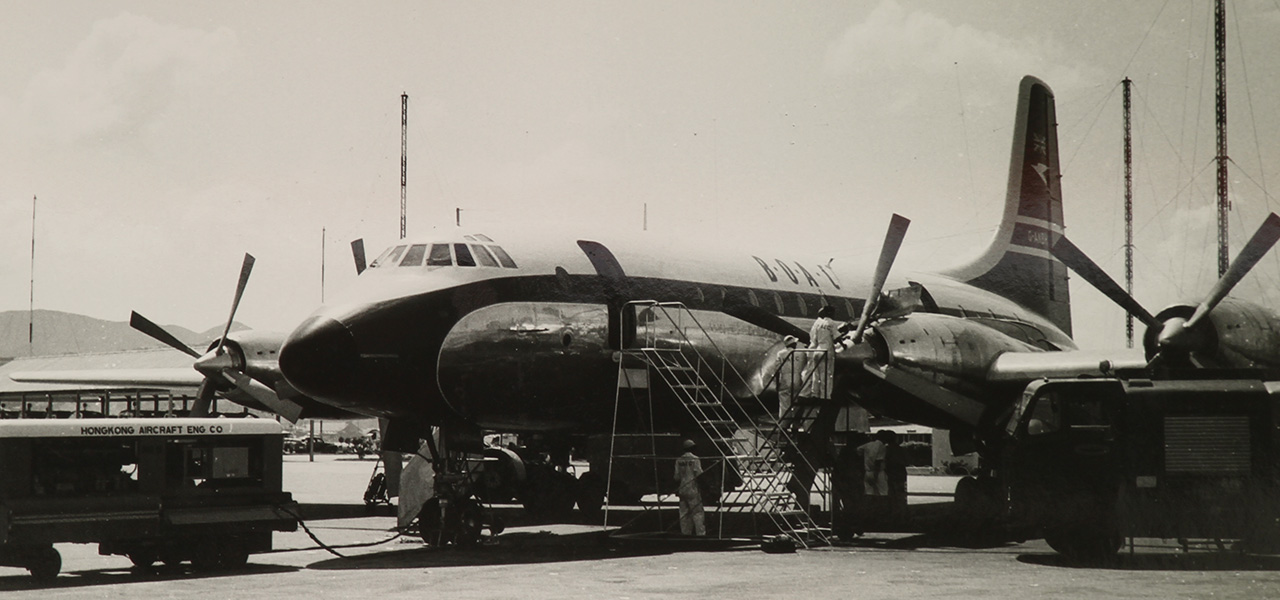Hong Kong Aircraft Engineering Company’s Years in Kai Tak
For more than half a century, Hong Kong Aircraft Engineering Company (HAECO) has been one of the most important aviation businesses. Not only has it seen the development of Hong Kong's aviation industry and the transformation of the communities around Kai Tak Airport after World War II, it also plays a unique part in global geo-politics because of its status as a strategic industrial venture.
After World War II, Hong Kong's aviation industry was in a state of destitution and yet to be revived. At that time, Swire and Jardine Matheson – two of Hong Kong’s major hongs – opened the Pacific Air Maintenance & Supply Company (PAMAS) and Jardine Air Maintenance Company (JAMCO) at Kai Tak Airport, respectively. These two small and crude maintenance hangars provided support and maintenance services to the airlines owned respectively by the two hongs. PAMAS served Cathay Pacific Airway since both belong to the Swire Group, whereas JAMCO served the Jardine-owned Hong Kong Airways as well as several other major airlines in the British Commonwealth, such as the British Overseas Airways Corporation. With the founding of the communist regime in China in 1949, flights between Hong Kong and China were terminated, dealing a serious blow to Hong Kong's aviation industry. In the face of depression, PAMAS with JAMCO merged in 1950 to form HAECO. At HAECO, there is a convergence of talents from different origins including aviation professionals from Swire, Jardine, the Far East Flying Training School that was based at Kai Tak since the pre-World War II period, the British Commonwealth, China National Aviation Corporation and Central Air Transport Corporation that moved to Hong Kong from Mainland China, and retired air force officers of the Kuomintang government. HAECO has since become the only maintenance hangar in Kai Tak Airport until its closure in 1998.
HAECO has grown along with Hong Kong’s aviation industry and the Kai Tak-based Cathay Pacific Airways. The Korean War in the 1950s and Vietnam War in the 1960s brought a large number of military aircrafts to Kai Tak, which rendered HAECO a rare opportunity in history for business development and technological enhancement. It also made Kai Tak a “rear base” behind the frontline of Cold War conflicts. This was a special chapter in Hong Kong’s industrial history. In the 1980s and 90s, the Hong Kong’s economy boomed and became China’s window to the world. Kai Tak, as a result, became one of the international aviation hubs. Against the backdrop where Hong Kong emerged as a leading economy in the world, HAECO bears great importance to the global aviation maintenance industry and has established itself, in a number of aspects, as the industry leader. It attracts many airlines around the world to send their aircrafts to Kai Tak for repair, or to invite HAECO staff to provide localised services overseas. Most notably, it contributed to bridging China’s civil aviation sector with the international world in the 1970s and 80s after the Cultural Revolution. HAECO’s staff had made first-hand contact with Mainland China’s aviation practitioners who were only then getting their first glimpse of the Western world. In this process, HAECO’s staff witnessed the deep cultural divide between Hong Kong and the mainland, and their experiences made very amazing narratives.
From the stories and experiences of HAECO’s staff, one can tell the history and changes of the Airport, but also the aviation industry in Hong Kong as well as the vicissitudes of neighbouring areas and communities in Kai Tak.
After World War II, Hong Kong's aviation industry was in a state of destitution and yet to be revived. At that time, Swire and Jardine Matheson – two of Hong Kong’s major hongs – opened the Pacific Air Maintenance & Supply Company (PAMAS) and Jardine Air Maintenance Company (JAMCO) at Kai Tak Airport, respectively. These two small and crude maintenance hangars provided support and maintenance services to the airlines owned respectively by the two hongs. PAMAS served Cathay Pacific Airway since both belong to the Swire Group, whereas JAMCO served the Jardine-owned Hong Kong Airways as well as several other major airlines in the British Commonwealth, such as the British Overseas Airways Corporation. With the founding of the communist regime in China in 1949, flights between Hong Kong and China were terminated, dealing a serious blow to Hong Kong's aviation industry. In the face of depression, PAMAS with JAMCO merged in 1950 to form HAECO. At HAECO, there is a convergence of talents from different origins including aviation professionals from Swire, Jardine, the Far East Flying Training School that was based at Kai Tak since the pre-World War II period, the British Commonwealth, China National Aviation Corporation and Central Air Transport Corporation that moved to Hong Kong from Mainland China, and retired air force officers of the Kuomintang government. HAECO has since become the only maintenance hangar in Kai Tak Airport until its closure in 1998.
HAECO has grown along with Hong Kong’s aviation industry and the Kai Tak-based Cathay Pacific Airways. The Korean War in the 1950s and Vietnam War in the 1960s brought a large number of military aircrafts to Kai Tak, which rendered HAECO a rare opportunity in history for business development and technological enhancement. It also made Kai Tak a “rear base” behind the frontline of Cold War conflicts. This was a special chapter in Hong Kong’s industrial history. In the 1980s and 90s, the Hong Kong’s economy boomed and became China’s window to the world. Kai Tak, as a result, became one of the international aviation hubs. Against the backdrop where Hong Kong emerged as a leading economy in the world, HAECO bears great importance to the global aviation maintenance industry and has established itself, in a number of aspects, as the industry leader. It attracts many airlines around the world to send their aircrafts to Kai Tak for repair, or to invite HAECO staff to provide localised services overseas. Most notably, it contributed to bridging China’s civil aviation sector with the international world in the 1970s and 80s after the Cultural Revolution. HAECO’s staff had made first-hand contact with Mainland China’s aviation practitioners who were only then getting their first glimpse of the Western world. In this process, HAECO’s staff witnessed the deep cultural divide between Hong Kong and the mainland, and their experiences made very amazing narratives.
From the stories and experiences of HAECO’s staff, one can tell the history and changes of the Airport, but also the aviation industry in Hong Kong as well as the vicissitudes of neighbouring areas and communities in Kai Tak.





